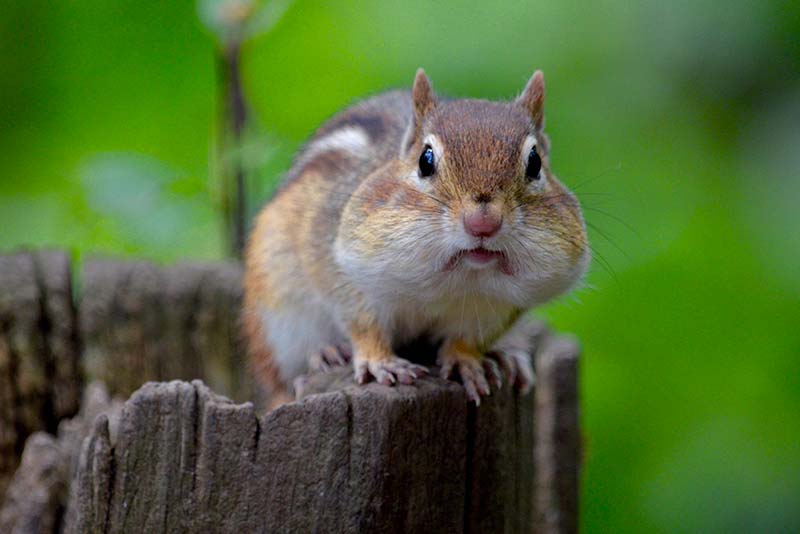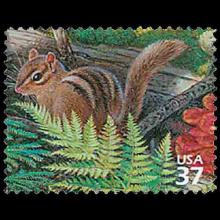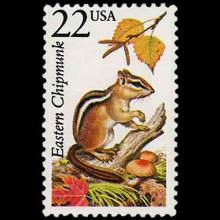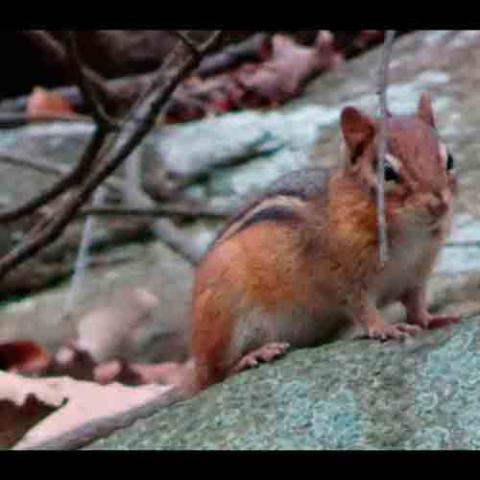NAMES
TAXONOMY
United States
Issued:
Stamp:
Tamias striatus
United States
Issued:
Stamp:
Tamias striatus
United States
Issued:
Stamp:
Tamias striatus
United States
Issued:
Stamp:
Tamias striatus
United States
Issued:
Stamp:
Tamias striatus
United States
Issued:
Stamp:
Tamias striatus
Mashomack Musings: Animals are busy preparing for winter
by Camilla Lynch, Oct. 12, 2020
 As bright green leaves turn to shades of fiery oranges and vibrant auburn, the days grow shorter and the air gets cooler, we know that our summer is coming to an end. Birds and butterflies migrate south, and Eastern Grey Squirrels (Sciurus carolinensis) and Eastern Chipmunks (Tamias striatus) become highly active as they prepare for the winter months. Interestingly, although often grouped together, chipmunks and squirrels do not prepare for winter in the same ways. Chipmunks are seen stuffing their cheeks with seeds and acorns. It is estimated that they can collect over 150 acorns per day. Chipmunks bring their stash into their 10 to 30-foot-long dens which have a vast tunnel system with separate areas for resting, storing food and eliminating waste. Although chipmunks disappear during the colder months they do not truly hibernate, instead they sleep for a few days at a time. Their body temperature dips to 40º and their heart rates slow to four beats per minute. When they wake, they stay below ground, raise their body temperature, feast, and dispose of any bodily waste. After resting from late October to March, they rise from their tunnels ready to forage once again. Squirrels do not hibernate either. They can stay active until the temperature drops below 30º. Like chipmunks, they also store acorns and other food sources for the winter, but often bury them. Grey squirrels live above ground. Their winter dens are found in holes of live, healthy trees. Squirrels rest for many days, then wake and search for their caches of nuts that they had stored previously. While both squirrels and chipmunks are still quite active now, next time you see them make sure to say goodbye, as they will soon be resting for the winter.
As bright green leaves turn to shades of fiery oranges and vibrant auburn, the days grow shorter and the air gets cooler, we know that our summer is coming to an end. Birds and butterflies migrate south, and Eastern Grey Squirrels (Sciurus carolinensis) and Eastern Chipmunks (Tamias striatus) become highly active as they prepare for the winter months. Interestingly, although often grouped together, chipmunks and squirrels do not prepare for winter in the same ways. Chipmunks are seen stuffing their cheeks with seeds and acorns. It is estimated that they can collect over 150 acorns per day. Chipmunks bring their stash into their 10 to 30-foot-long dens which have a vast tunnel system with separate areas for resting, storing food and eliminating waste. Although chipmunks disappear during the colder months they do not truly hibernate, instead they sleep for a few days at a time. Their body temperature dips to 40º and their heart rates slow to four beats per minute. When they wake, they stay below ground, raise their body temperature, feast, and dispose of any bodily waste. After resting from late October to March, they rise from their tunnels ready to forage once again. Squirrels do not hibernate either. They can stay active until the temperature drops below 30º. Like chipmunks, they also store acorns and other food sources for the winter, but often bury them. Grey squirrels live above ground. Their winter dens are found in holes of live, healthy trees. Squirrels rest for many days, then wake and search for their caches of nuts that they had stored previously. While both squirrels and chipmunks are still quite active now, next time you see them make sure to say goodbye, as they will soon be resting for the winter.
The author is a high school student, volunteering at Mashomack for her fall semester.
Photo Credit: Ashley Lee
Genus species (Animalia): Tamias striatus
The eastern chipmunk (Tamias striatus) is a chipmunk species found in eastern North America. It is the only living member of the chipmunk subgenus Tamias, sometimes recognized as a separate genus. The name "chipmunk" comes from the Ojibwe word ajidamoo (or possibly ajidamoonh, the same word in the Ottawa dialect of Ojibwe), which translates literally as "one who descends trees headlong."
Description
A small species, it reaches about 30 cm (12 in) in length including the tail, and a weight of 66–150 g (2.3–5.3 oz). It has reddish-brown fur on its upper body and five dark brown stripes contrasting with light brown stripes along its back, ending in a dark tail. It has lighter fur on the lower part of its body. It has a tawny stripe that runs from its whiskers to below its ears, and light stripes over its eyes. It has two fewer teeth than other chipmunks and four toes each on the front legs, but five on the hind legs.
Habitat
The eastern chipmunk lives in deciduous wooded areas and urban parks throughout the eastern United States and southern Canada. It prefers locations with rocky areas, brush or log piles, and shrubs to provide cover.
Behavior
It can climb trees well, but constructs underground nests with extensive tunnel systems, often with several entrances. To hide the construction of its burrow, the eastern chipmunk carries soil to a different location in its cheek pouches. It also lines the burrow with leaves, rocks, sticks, and other material, making it even harder to see. It has several bird-like or chattering calls; one is a trill at the rate of 130 vibrations per minute and another is a lower-pitched, clicking sound.
Diet
It is mainly active during the day, spending most of its day foraging. It prefers bulbs, seeds, fruits, nuts, green plants, mushrooms, insects, worms, and bird eggs. Like other chipmunks, it transports food in pouches in its cheeks.
Lifecycle
The eastern chipmunk defends its burrow and lives a solitary life, except during mating season. Females usually produce one or two litters of three to five young. The two breeding seasons are from February to April and from June to August. During the winter, the chipmunk may enter long periods of torpor, but does not truly hibernate.
Predators of the eastern chipmunk include hawks, owls, foxes, raccoons, snakes, weasels, coyotes, bobcats, lynx, domestic dogs and domestic cats. On average, eastern chipmunks live three or more years in the wild, but in captivity they may live as long as eight years.




